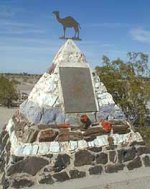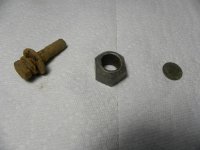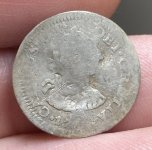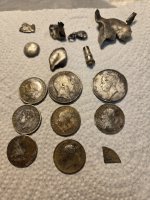pegleglooker
Bronze Member
- Jun 9, 2006
- 1,857
- 237
- Detector(s) used
- ace 250
- Primary Interest:
- All Treasure Hunting
Her's a odd tale...
PLL
By Chuck Woodbury
editor, Out West
Hi Jolly and the U.S. Camel Corps are honored at Hi Jolly's grave in Quartzsite.
QUARTZSITE, Ariz. -- One of the most interesting military experiments of the American West involved 77 camels and a Syrian named Hi Jolly. His real name was Hadji Ali, and he's remembered today at a pyramid-shaped monument in the Quartzsitecemetery.
The story of Hi Jolly began in 1855 when Secretary of War Jefferson Davis was told of an innovative plan to import camels to help build and supply a Western wagon route from Texas to California. It was a dry, hot and otherwise hostile region, not unlike the camel's natural terrain in the Middle East.
Davis, convinced of the idea, proposed a Camel Military Corps to Congress. "For military purposes, and for reconnaissances, it is believed the dromedary would supply a want now seriously felt in our service," he explained.
Congress agreed and appropriated $30,000.
Major Henry Wayne was sent to the Middle East where he bought 33 of the animals. With much difficulty, they were loaded onto a Navy ship (with part of its deck modified to accommodate the large creatures) and transported to Texas. There Lieutenant Edward Fitzgerald Beale took over. Forty-four more camels arrived later.
Hadji Ali and another foreigner were hired to teach the soldiers how to pack the animals. The Americans had a hard time pronouncing Ali's name so they nicknamed him Hi Jolly.
Beale left on a Western expedition in June, 1857, with Hi Jolly along as chief camel driver. Camels were loaded with 600 to 800 pounds each and traveled 25 to 30 miles a day. If the animals fared well, a series of Army posts could be set up later along the route to relay mail and supplies across the Southwest.
After reaching California the expedition returned to Texas, a success -- at least to Beale.
"The harder the test they (the camels) are put to, the more fully they seem to justify all that can be said of them," Beale wrote. "They pack water for days under a hot sun and never get a drop; they pack heavy burdens of corn and oats for months and never get a grain; and on the bitter greasewood and other worthless shrubs, not only subsist, but keep fat."
He concluded, "I look forward to the day when every mail route across the continent will be conducted and worked altogether with this economical and noble brute."
But perhaps he was too optimistic. What he didn't say was that the camels didn't take to the West's rocky soil. And prospectors' burros and mules -- and even Army mules -- were afraid of the odd-looking creatures and would sometimes panic at their sight.
Still, in 1858, then-Secretary of War John Floyd told Congress, "The entire adaptation of camels to military operations on the Plains may now be taken as demonstrated."
He urged Congress to authorize the purchase of 1,000 more camels.
Congress didn't act, however, as it was preoccupied with trouble brewing between the North and South.
With the first shots of the Civil War, the Camel Military Corps was as good as dead. Most of the animals were auctioned off, although a few escaped into the desert where most were shot by prospectors and hunters as pests.
Hi Jolly kept a few and started a freighting business between the Colorado River ports and mining camps to the east. The business failed, however, and Jolly released his last camel in the desert near Gila Bend. Years later, after marrying a Tucson woman and fathering two children, Hi Jolly moved to Quartzsite where he mined with a burro. He died in 1902 at age 73 and was buried in the Quartzsite Cemetery.

To his dying day, Hi Jolly believed that a few of the camels still roamed the desert. Some people think the ghosts of some still do.
From Out West #18
PLL
By Chuck Woodbury
editor, Out West
Hi Jolly and the U.S. Camel Corps are honored at Hi Jolly's grave in Quartzsite.
QUARTZSITE, Ariz. -- One of the most interesting military experiments of the American West involved 77 camels and a Syrian named Hi Jolly. His real name was Hadji Ali, and he's remembered today at a pyramid-shaped monument in the Quartzsitecemetery.
The story of Hi Jolly began in 1855 when Secretary of War Jefferson Davis was told of an innovative plan to import camels to help build and supply a Western wagon route from Texas to California. It was a dry, hot and otherwise hostile region, not unlike the camel's natural terrain in the Middle East.
Davis, convinced of the idea, proposed a Camel Military Corps to Congress. "For military purposes, and for reconnaissances, it is believed the dromedary would supply a want now seriously felt in our service," he explained.
Congress agreed and appropriated $30,000.
Major Henry Wayne was sent to the Middle East where he bought 33 of the animals. With much difficulty, they were loaded onto a Navy ship (with part of its deck modified to accommodate the large creatures) and transported to Texas. There Lieutenant Edward Fitzgerald Beale took over. Forty-four more camels arrived later.
Hadji Ali and another foreigner were hired to teach the soldiers how to pack the animals. The Americans had a hard time pronouncing Ali's name so they nicknamed him Hi Jolly.
Beale left on a Western expedition in June, 1857, with Hi Jolly along as chief camel driver. Camels were loaded with 600 to 800 pounds each and traveled 25 to 30 miles a day. If the animals fared well, a series of Army posts could be set up later along the route to relay mail and supplies across the Southwest.
After reaching California the expedition returned to Texas, a success -- at least to Beale.
"The harder the test they (the camels) are put to, the more fully they seem to justify all that can be said of them," Beale wrote. "They pack water for days under a hot sun and never get a drop; they pack heavy burdens of corn and oats for months and never get a grain; and on the bitter greasewood and other worthless shrubs, not only subsist, but keep fat."
He concluded, "I look forward to the day when every mail route across the continent will be conducted and worked altogether with this economical and noble brute."
But perhaps he was too optimistic. What he didn't say was that the camels didn't take to the West's rocky soil. And prospectors' burros and mules -- and even Army mules -- were afraid of the odd-looking creatures and would sometimes panic at their sight.
Still, in 1858, then-Secretary of War John Floyd told Congress, "The entire adaptation of camels to military operations on the Plains may now be taken as demonstrated."
He urged Congress to authorize the purchase of 1,000 more camels.
Congress didn't act, however, as it was preoccupied with trouble brewing between the North and South.
With the first shots of the Civil War, the Camel Military Corps was as good as dead. Most of the animals were auctioned off, although a few escaped into the desert where most were shot by prospectors and hunters as pests.
Hi Jolly kept a few and started a freighting business between the Colorado River ports and mining camps to the east. The business failed, however, and Jolly released his last camel in the desert near Gila Bend. Years later, after marrying a Tucson woman and fathering two children, Hi Jolly moved to Quartzsite where he mined with a burro. He died in 1902 at age 73 and was buried in the Quartzsite Cemetery.

To his dying day, Hi Jolly believed that a few of the camels still roamed the desert. Some people think the ghosts of some still do.
From Out West #18


 Supposedly truckers back in the early days of trucking (1920s/30s) ..... driving the desert roads at night, swore they had seen a camel(s) out in the desert night, that ran off at the approaching lights.
Supposedly truckers back in the early days of trucking (1920s/30s) ..... driving the desert roads at night, swore they had seen a camel(s) out in the desert night, that ran off at the approaching lights. 




